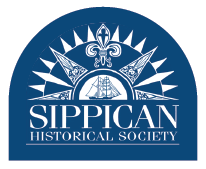In its third year, the J.W. Rosbe Education Fund offers a yearly scholarship and oppportunity to discover the Sippican Historical Society (SHS) collection. The first two recipients, Emma Williamson and Jamie Mackenzie, wrote reports and received scholarships for college expenses. In 2023, SHS offered a paid, part-time summer internship to Laurel Alpaugh. Here’s a bit about Laurel’s experience…

My first task as the newest intern of the Sippican Historical Society was archiving postcards from a lovely donation. My interest peaked when I was given a book on Marion postcards, A Picture Postcard History of Marion, Massachusetts, published by our very own Pete Smith. This book features many beautiful postcards that Pete spent lots of time tracking down and acquiring, sometimes even taking his efforts overseas. Postcards will forever hold an important place in how we communicate, and Marion played a part in this method of communication.
As I scanned the collection, it was fascinating to see buildings such as the buildings lining Main Street and the older Tabor buildings in all their glory. My favorite postcard is of the Hotel Sippican, which is cataloged as 2017.004.095 in our collection. Published by Leipzig Munchen Retchner Bros, it was made in Germany for C. W. Ripley, the proprietor of Hotel Sippican from 1882 – 1922. While archiving this acquisition, I found many postcards of the fabulous hotel in the collection. However, this one stood out to me, not only because of its depiction of the majestic building but also because of its reflective quality.
Although it’s hard to capture this quality (which is why you should come in and visit!), the sky in the card features gorgeous metallic pinks and blues that melt into each other and radiate when the card is moved.
Of the various images of this building (and there are many), this postcard does a great job showing the size of the building, which was rather massive, and indicative of the scale of tourism here during the Golden Age. Pete features the postcard in his section of the book “The Sippican Hotel & Casino,” where he mentions that the negative of the photograph used for the postcard of the hotel was embellished, calling attention to the (fictitious) addition of five dormers on the roof to make the stunning building seem even grander.
With the rise of their popularity during this Golden Age, postcards spread advertisements specifically regarding tourism and were a simple way for people to communicate and show where they were vacationing. The Sippican Hotel, located at the corner of South and Water Streets, was once a powerhouse for tourism in Marion. It was considered one of the most famous hotels in New England at its height and housed up to 200 guests, who would come from all over to get a glimpse of Marion and its beauty in the summertime. Although the hotel was demolished in 1929 and the Golden Age has ended, our postcards serve as tangible memories of the past. Thanks to books like Pete’s and artifacts such as this donated collection of scenic postcards, the history of Marion and its Golden Age continues to live on, educate, and entertain.
